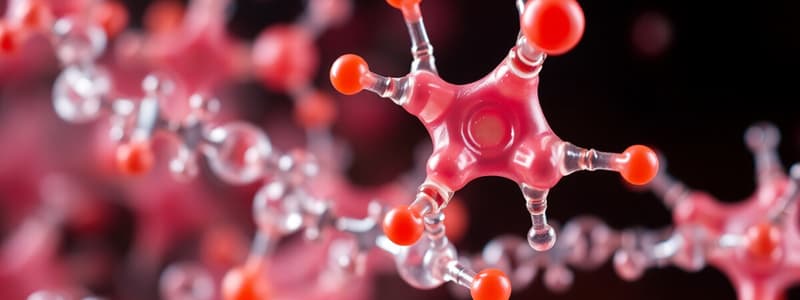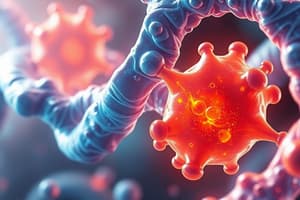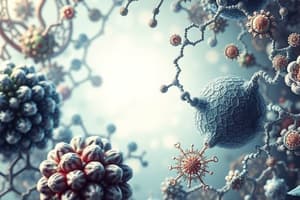Podcast
Questions and Answers
Which characteristic of enzymes is most directly related to their function in biological systems?
Which characteristic of enzymes is most directly related to their function in biological systems?
- Their capacity to be synthesized from various types of organic molecules.
- Their ability to be consumed in the reactions they catalyze.
- Their high degree of specificity for substrates. (correct)
- Their presence in equal concentrations in all types of cells.
An enzyme's active site is crucial for its function. What is the active site's primary role?
An enzyme's active site is crucial for its function. What is the active site's primary role?
- To bind substrates and facilitate a chemical reaction. (correct)
- To regulate enzyme production within the cell.
- To provide structural support to the enzyme molecule.
- To protect the enzyme from degradation.
How does an enzyme affect the activation energy of a chemical reaction?
How does an enzyme affect the activation energy of a chemical reaction?
- It does not affect the activation energy.
- It increases the activation energy.
- It stabilizes the transition state without altering the activation energy.
- It lowers the activation energy. (correct)
Which of the following is NOT a main class according to the EC number classification system for enzymes?
Which of the following is NOT a main class according to the EC number classification system for enzymes?
How do competitive inhibitors affect enzyme activity?
How do competitive inhibitors affect enzyme activity?
Which statement best describes the function of coenzymes?
Which statement best describes the function of coenzymes?
What is the role of metalloproteins in enzyme function?
What is the role of metalloproteins in enzyme function?
How do non-competitive inhibitors affect enzyme-substrate binding?
How do non-competitive inhibitors affect enzyme-substrate binding?
Which vitamin is a precursor for flavin adenine dinucleotide (FAD) and flavin mononucleotide (FMN)?
Which vitamin is a precursor for flavin adenine dinucleotide (FAD) and flavin mononucleotide (FMN)?
What is the function of lyases (EC 4) in enzymatic reactions?
What is the function of lyases (EC 4) in enzymatic reactions?
What is the chemical nature of heterocyclic compounds?
What is the chemical nature of heterocyclic compounds?
Which of the following is an example of a biologically important porphyrin derivative?
Which of the following is an example of a biologically important porphyrin derivative?
What is the key structural difference between nucleosides and nucleotides?
What is the key structural difference between nucleosides and nucleotides?
Which type of bond links nucleotides together in nucleic acids?
Which type of bond links nucleotides together in nucleic acids?
Which of the following is a primary function of nucleic acids in cells?
Which of the following is a primary function of nucleic acids in cells?
What is the base pairing rule in DNA?
What is the base pairing rule in DNA?
Which of the following is a key structural difference between DNA and RNA?
Which of the following is a key structural difference between DNA and RNA?
How does temperature affect enzyme activity?
How does temperature affect enzyme activity?
Which of the following best describes the 'induced-fit' theory of enzyme-substrate interaction?
Which of the following best describes the 'induced-fit' theory of enzyme-substrate interaction?
Which class of enzymes catalyzes the transfer of chemical groups from one substrate to another?
Which class of enzymes catalyzes the transfer of chemical groups from one substrate to another?
What is the role of Vitamin C (Ascorbic Acid) as described in the text?
What is the role of Vitamin C (Ascorbic Acid) as described in the text?
Which vitamin is part of coenzyme A (CoA), involved in energy production and lipid/amino acid metabolism?
Which vitamin is part of coenzyme A (CoA), involved in energy production and lipid/amino acid metabolism?
What distinguishes irreversible enzyme inhibitors from reversible inhibitors?
What distinguishes irreversible enzyme inhibitors from reversible inhibitors?
How do enzymes typically lower the activation energy of a reaction?
How do enzymes typically lower the activation energy of a reaction?
What is the purpose of classifying enzymes using the EC numbering system?
What is the purpose of classifying enzymes using the EC numbering system?
What is the role of cofactors in enzyme activity?
What is the role of cofactors in enzyme activity?
Which of these statements regarding enzyme specificity is most accurate?
Which of these statements regarding enzyme specificity is most accurate?
What primarily determines the specificity of an enzyme for its substrate?
What primarily determines the specificity of an enzyme for its substrate?
What type of enzymatic reaction is catalyzed by hydrolases?
What type of enzymatic reaction is catalyzed by hydrolases?
Which of the following best describes the function of ligases (EC 6)?
Which of the following best describes the function of ligases (EC 6)?
What is the function of transfer RNA (tRNA)?
What is the function of transfer RNA (tRNA)?
What is the role of activators regarding enzyme activity?
What is the role of activators regarding enzyme activity?
Based on the information provided, how would you classify an enzyme whose primary function is to rearrange the atoms within a molecule?
Based on the information provided, how would you classify an enzyme whose primary function is to rearrange the atoms within a molecule?
Which of the following is characteristic of non-competitive enzyme inhibition?
Which of the following is characteristic of non-competitive enzyme inhibition?
In the context of enzyme catalysis, what is meant by the term 'transition state'?
In the context of enzyme catalysis, what is meant by the term 'transition state'?
Which statement accurately describes the function and composition of messenger RNA (mRNA)?
Which statement accurately describes the function and composition of messenger RNA (mRNA)?
What is the role of the 'subclass' in the EC number of an enzyme?
What is the role of the 'subclass' in the EC number of an enzyme?
Translocases (EC 7) were added in 2018. What type of reaction do they catalyze?
Translocases (EC 7) were added in 2018. What type of reaction do they catalyze?
How does the EC numbering system classify enzymes?
How does the EC numbering system classify enzymes?
What is the primary difference between reversible and irreversible enzyme inhibitors regarding their interaction with enzymes?
What is the primary difference between reversible and irreversible enzyme inhibitors regarding their interaction with enzymes?
Which of the following best describes the role of coenzymes in enzyme function?
Which of the following best describes the role of coenzymes in enzyme function?
Which of the following is the most accurate description of metalloenzymes?
Which of the following is the most accurate description of metalloenzymes?
Flashcards
Enzymes
Enzymes
Biological catalysts accelerating reaction rates in living cells.
Enzyme Specificity
Enzyme Specificity
Enzymes specifically catalyze reactions involving particular substrates.
Active Site
Active Site
Region on an enzyme where the substrate binds.
EC Number
EC Number
Signup and view all the flashcards
Oxidoreductases (EC 1)
Oxidoreductases (EC 1)
Signup and view all the flashcards
Transferases (EC 2)
Transferases (EC 2)
Signup and view all the flashcards
Hydrolases (EC 3)
Hydrolases (EC 3)
Signup and view all the flashcards
Lyases (EC 4)
Lyases (EC 4)
Signup and view all the flashcards
Isomerases (EC 5)
Isomerases (EC 5)
Signup and view all the flashcards
Ligases (EC 6)
Ligases (EC 6)
Signup and view all the flashcards
Translocases (EC 7)
Translocases (EC 7)
Signup and view all the flashcards
Enzyme Inhibitors
Enzyme Inhibitors
Signup and view all the flashcards
Reversible Inhibition
Reversible Inhibition
Signup and view all the flashcards
Irreversible Inhibition
Irreversible Inhibition
Signup and view all the flashcards
Competitive Inhibitors
Competitive Inhibitors
Signup and view all the flashcards
Non-competitive Inhibitors
Non-competitive Inhibitors
Signup and view all the flashcards
Cofactor
Cofactor
Signup and view all the flashcards
Coenzymes
Coenzymes
Signup and view all the flashcards
Metalloproteins
Metalloproteins
Signup and view all the flashcards
Water-Soluble Vitamins
Water-Soluble Vitamins
Signup and view all the flashcards
Heterocyclic Compounds
Heterocyclic Compounds
Signup and view all the flashcards
Porphyrins
Porphyrins
Signup and view all the flashcards
Heme
Heme
Signup and view all the flashcards
Nucleoside
Nucleoside
Signup and view all the flashcards
Nucleotide
Nucleotide
Signup and view all the flashcards
Nucleic Acids
Nucleic Acids
Signup and view all the flashcards
DNA
DNA
Signup and view all the flashcards
RNA
RNA
Signup and view all the flashcards
Study Notes
Enzymes: Biological Catalysts
- Enzymes catalyze reactions essential for life
- Required for almost every chemical reaction in living cells
- Exhibit specificity, enhancing reaction rates without being consumed
- Specificity is due to complementary characteristics between enzyme and substrate
Enzyme-Substrate Interaction
- Enzymes bind substrates at the active site which forms the enzyme-substrate complex
- Active site is a pocket formed by the enzyme's tertiary and quaternary structure
- The Lock and Key theory and the Induced-fit theory are proposed to explain specificity
Enzyme Nomenclature and Classification
- Enzyme names typically end with "-ase"
- Enzymes are classified using an EC (Enzyme Commission) number
- There are six (now seven) main classes based on reaction type
Enzyme Classes
- Oxidoreductases (EC 1) mediate oxidation/reduction
- Transferases (EC 2) transfer chemical groups
- Hydrolases (EC 3) catalyze hydrolysis of chemical bonds
- Lyases (EC 4) facilitate cleavage of chemical bonds without oxidation or hydrolysis
- Isomerases (EC 5) affect geometric and structural changes
- Ligases (EC 6) catalyze joining of two compounds using ATP
- Translocases (EC 7) transport substances across membranes (added in 2018)
- The EC number is composed of four digits to show the class, subclass, and serial number of the enzyme
Enzyme Properties and Regulation
- Enzymes significantly speed up reactions
- Activity is regulated by temperature, pH, and additives
- Enzymes lower activation energy by altering the reaction's transition state
- Enzyme activity is strongly influenced by pH and temperature
- Specific pH and temperature ranges are optimal for enzyme function
- Enzyme activity is modulated by inhibitors and activators
- Many drugs and poisons act as enzyme inhibitors
Enzyme Inhibition
- Reversible inhibition occurs through non-covalent interactions
- Irreversible inhibition occurs through covalent bond
- Competitive inhibitors bind to the active site
- Non-competitive inhibitors bind elsewhere, altering enzyme shape and activity
Enzyme Activation
- Activation can be by ions (Ca2+, Mg2+), cofactors, coenzymes, or proenzyme conversion
- Activation converts inactive molecules into metabolically active ones
Cofactors and Coenzymes
- Some enzymes require cofactors or coenzymes to function
- Cofactors are inorganic ions or organic molecules that assist enzymes
- Coenzymes are organic molecules serving as cofactors, often derived from vitamins
Metalloproteins and Vitamins
- Metalloenzymes contain tightly bound metal ions at active sites
- Water-soluble vitamins are precursors to coenzymes
- B vitamins (Thiamin, Riboflavin, Niacin, Pantothenic Acid, Pyridoxine, Biotin, Folic Acid, Cobalamin) and Vitamin C are included
Specific Vitamins and Their Roles
- Thiamin (Vitamin B1) is part of thiamin pyrophosphate (TPP), which is involved in decarboxylation reactions
- Riboflavin (Vitamin B2) forms flavin adenine dinucleotide (FAD) and flavin mononucleotide (FMN), used in redox reactions
- Niacin (Vitamin B3) forms nicotinamide adenine dinucleotide (NAD+) and NADP+, used in redox reactions
- Pantothenic Acid (Vitamin B5) part of coenzyme A (CoA), involved in energy production and lipid/amino acid metabolism
- Pyridoxine (Vitamin B6) converted to pyridoxal phosphate (PLP), involved in amino acid transamination and decarboxylation
- Biotin is involved in carboxyl-group transfer reactions
- Folic Acid (B9) forms tetrahydrofolate (THFA), used in nucleic acid synthesis
- Cobalamin (Vitamin B12) is involved in methyl group transfer
- Vitamin C (Ascorbic Acid) acts as an antioxidant and is involved in collagen synthesis and biogenic amine biosynthesis
Heterocyclic Compounds
- Heterocyclic compounds have one or more carbon atoms replaced by heteroatoms
- Common heteroatoms are oxygen, nitrogen, or sulfur
- Can be classified by number of atoms in the ring, type of heteroatoms, or number of rings
Biologically Important Heterocyclic Compounds
- Pyrrole derivatives (Porphyrins): Pyrrole rings form the building blocks
- Heme: Iron-porphyrin complex, imparts the color to arterial blood and is found in hemoglobin
- Indole: A fused-ring system found in tryptophan and its derivatives
- Pyrimidines (Cytosine, Thymine, Uracil): Bases in nucleic acids
- Purines (Adenine, Guanine): Bases in nucleic acids
Nucleosides and Nucleotides
- Nucleosides are nitrogenous bases linked to a sugar via a glycosidic bond
- Nucleotides are nucleosides with one or more phosphate groups attached to the sugar
Nucleotide Function
- Nucleotides serve as building blocks for DNA and RNA
- They are intracellular energy sources (ATP)
- They are also mediators in signaling
Nucleic Acids: DNA and RNA
- Nucleic acids are polymers of nucleotides linked by phosphodiester bonds
- Store information for cellular growth and reproduction
- Two types: DNA (deoxyribonucleic acid) and RNA (ribonucleic acid)
DNA (Deoxyribonucleic Acid)
- Double-stranded helix
- Contains deoxyribose sugar
- Bases: Adenine (A), Guanine (G), Cytosine (C), Thymine (T)
- Base pairing: A-T, G-C
- Primary structure: 2-deoxy-ribose and phosphate units that alternate in the backbone
RNA (Ribonucleic Acid)
- Single-stranded
- Contains ribose sugar
- Bases: Adenine (A), Guanine (G), Cytosine (C), Uracil (U)
- Functions: mRNA (messenger), rRNA (ribosomal), tRNA (transfer)
Key Differences between DNA and RNA
- RNA is single-stranded and shorter
- DNA is double-stranded and very long
- DNA nucleotides have deoxyribose and Thymine
- RNA nucleotides have ribose and Uracil
Conclusion
- Enzymes, cofactors, heterocyclic compounds, nucleotides, and nucleic acids are essential, and understanding them can develop new therapies for diseases
Studying That Suits You
Use AI to generate personalized quizzes and flashcards to suit your learning preferences.



